A guest project by Dan Newman, contributing Evil Mad Scientist.
For my Eggbot plotting, I’ve had two seemingly exclusive goals: to execute
designs with food safe inks, and to use pens capable of producing fine, crisp
lines. Now, thanks to Lenore’s recent investigation of food safe markers combined with a simple five minute pen modification, it’s possible to achieve both goals with the same pen. Yes, I can have my eggs and eat them too!
As Lenore demonstrated in her investigation, unmodified KopyKake Edible Ink Coloring
Pens do a fair job of drawing on eggs, producing legible printing. However, they produce relatively thick lines of about 0.8 mm which lack the crispness typical of quality fiber tip technical pens. This would seem to make them unsuited for detailed designs or designs with small print [1]. However, it’s possible to replace a KopyKake’s original nib with that of a fiber tip technical pen. Specifically, a replacement nib for a Copic Multiliner SP. The result is a food safe pen which rivals any of the fiber tipped technical pens.
To execute this mod, you will need:
- A KopyKake Edible Ink Coloring Pen,
- A replacement nib for a Copic Multiliner SP pen,
- A small amount of masking tape,
- A pair of scissors or a knife to cut the tape with, and
- A pair of pliers or other tool for removing the KopyKake’s original
nib.
Replacement nibs for Copic Multiliner SP pens come in a range of sizes from 0.03 to 0.70 mm. Avoid the 0.03, 0.05, and 0.01 mm size nibs as they have a feeder filament which is too fine and too short for use with a KopyKake marker without extra care and modifications [2]. Within the United States, these nibs may be purchased online from Dick Blick Art Materials. The 0.20 and 0.25 mm nibs are slightly cheaper than the other sizes as they come two to a package instead of just one.
For this modification, we will use a 0.20 mm replacement nib.
Before proceeding with the modification, let’s look closely at a KopyKake pen. The pen actually has drawing nibs at each end of its barrel. At one end, there is a narrow nib, while at the other end, there is a wider, conical nib.
As it turns out, the narrower nib draws a thicker line than the wider nib. This is because the narrower nib is softer than the wider one. Ideally, we’d replace this narrower nib, keeping the wider nib. That way, our modified pen could draw both very fine lines and medium lines. Unfortunately, it is the wider nib which we will replace: the section of the pen barrel which holds this wider nib is nearly the right inside diameter for accepting the Copic replacement nib [3].
With a pair of pliers, grip the wider nib and pull it straight out. It should remove quite easily. You may even be able to remove the nib with your scissors just slightly biting into the nib. If you wish, you can save this nib for later re-use: just put it into a plastic bag to keep it clean. (It’s okay for it to dry out.)
Now, remove the replacement Copic nib from its packaging. If you try to insert the replacement nib into the KopyKake pen, you should see that the fit is a little too loose.
To make it a little more tight, cut a very small piece of masking tape. The tape should be no wider than the the section of the nib’s collar which will be inserted into the pen’s barrel. Moveover, the tape does not need to completely wrap around the collar. Only going about half to two-thirds around is sufficient to make the nib fit well yet still be removable.
Once you have secured the tape to the nib, go ahead and insert the nib into the pen. Push it down until the nib’s collar seats itself against the end of the pen’s barrel. After a minute or two, you should see the new nib’s color change from milky-white to that of the pen’s ink color [4]. Make sure that the pen’s cap fits on well: if it wants to fall right off, you may not have the new nib inserted all the way. You’re now ready to draw with your modified pen!
Some quick comparisons show that the original pen tip draws a 0.75 or 0.80 mm line; whereas, the replacement tip draws a line of one-third that width (0.25 mm).
An even closer shot of the line widths.
How well does the modification work? In the above photo, the egg on the left was drawn with the unmodified KopyKake pen, while the egg on the right with the modified pen. There does appear to be a loss in color saturation with the modification. Note, however, that some — but not all — of that loss is a result of the lines simply being narrower.
Can AmeriColor Gourmet Writer Food Color Markers be modified as well? Yes, but the results are not very encouraging. The modification can be done with the assistance of a small twist drill bit,
- Remove the pen’s nib,
- Drill out the end of the barrel with a 3.5 mm drill bit
(0.135 inches; American #29 twist drill bit), and then - Insert the Copic replacement nib; no masking tape is needed.
However, the Eggbot plotting results are no better than those with the unmodified pen: the inks in the AmeriColor pens demonstrate a considerable amount of bleeding. While my modified AmeriColor pen drew very nice, tight lines on paper, I saw terrible bleeding on duck eggs. Initially the lines would look reasonable, but a minute
later the inks had bleed. And note that the egg shell was quite dry: this bleeding was not the result of moisture on or in the shell. It was repeatable with a chicken egg as well.
I have not tried modifying Wilton FoodWriter pens: the ends of their barrels look too big to accomodate a replacement nib without the use of an adapter bushing. Should you try modifying one of these pens, please do leave a comment describing your experience.
Notes
- It’s also not clear how well a KopyKake’s original nib will hold up to drawing
on eggs. The original nibs appear as though they may soften and flatten
somewhat quickly. - The 0.03, 0.05, and 0.10 mm nibs have a finer, shorter filament. To
use them, you will need to cut about 2 to 3 mm off the end of the
barrel’s tip. This is easily done with a knife. When inserting the
replacement nib, be sure to not bend the filament. - To instead use the KopyKake’s barrel end with the narrower nib, you will
need to drill the end out with a 3.5 mm twist drill bit (0.135 inches;
American #29 twist drill bit). - If the new nib does not take up ink after several minutes, then the nib’s
feeder filament is not penetrating sufficiently into the pen’s ink resevoir (which is just a long cylinder of fibrous material saturated with ink). Make sure that the nib is seated as far as it will go into the barrel. You can cut a millimeter or two off the end of the barrel with a knife in order to allow the feeder filament to penetrate further into the ink resevoir.




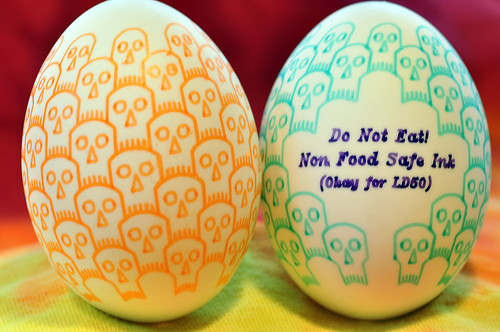
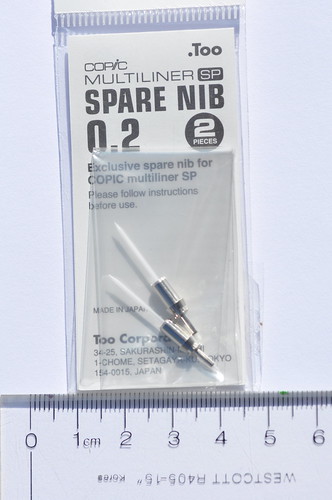
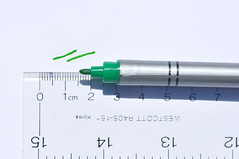

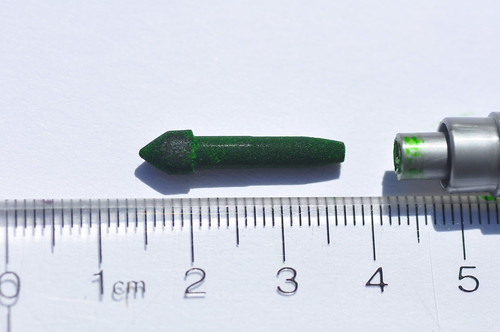
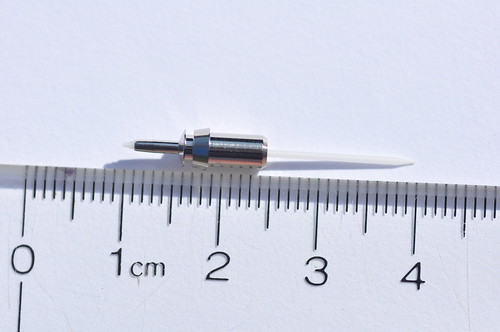
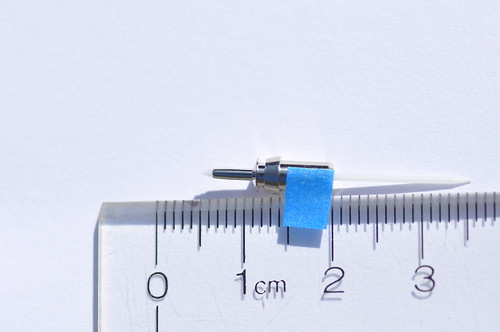
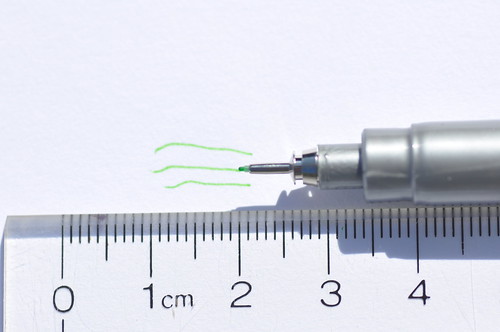



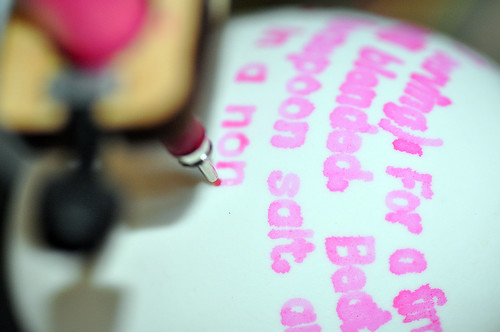
Is the pen tip food safe? I would worry that it had some sort of chemical treatment to the wick to keep it happy on the shelves.
I cannot imagine why the nibs would require a chemical treatment. They are made of a fairly dense, very fine synthetic fiber. The nibs are certified ASTM D-4236 "Non-toxic", just like crayons, playdough, and other art materials which need to be safe enough for the occasional consumption by kids. (Not that I recommend eating the nibs, mind you.) And yes, being certified "Non-toxic" is not the same thing as being what one might commonly think of as being "food safe". As in all things in life, use your best judgement.
Dan
Can someone tell me if these are safe and effective to use on waxed paper snack cups? I want to make jello shots and write on the paper cups with a black food-safe pen after the jello has chilled.
(I tried to start a new thread and got an error, sorry)
It’s likely that all of these pens are food safe, but unlikely that any of the ink will stick to wax paper.
Windell H. Oskay
drwho(at)evilmadscientist.com
http://www.evilmadscientist.com/
What’s the fuss, anyway?? I have not seen a permanent marker that penetrates throgh the eggshell. An another matter would be if you would write on a cooked egg without shell… …then the edibility would decrease rapidly due bacterical growth.
JSa
You have not seen a permanent marker where the *pigment* bleeds through. I have.
The solvents can also penetrate without bringing pigment with them, making the contamination invisible.
And of course, someone handling the egg, and then eating it, can get contaminants on their hands (not necessarily the pigments, again, so no visible staining) and then on the egg after shelling it.
Food safety is about more than just visible dirt.
food safety is also not being an uptight rrrs about it, or finding out what the lower limits for your perceived threat are. The stress and unhappiness you get from ‘better safe than sorry’ ignorance will cut 2 happy years from your life. Don’t worry, be happy!
I get more stress and unhappiness from reading commentary such as yours.
Thank you for your response!
I had a sneaking suspicion that would be the case with the pens. *sigh*
You have better handwriting than my printer.
That’s not handwriting, it’s eggbot plotting.